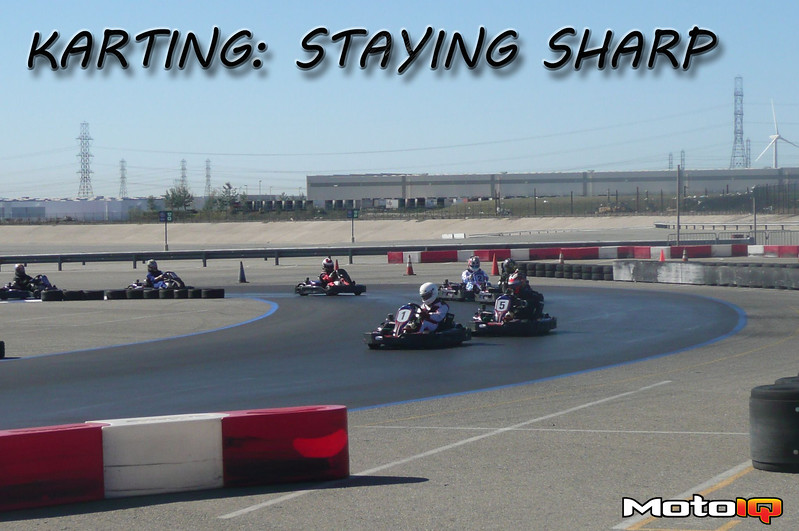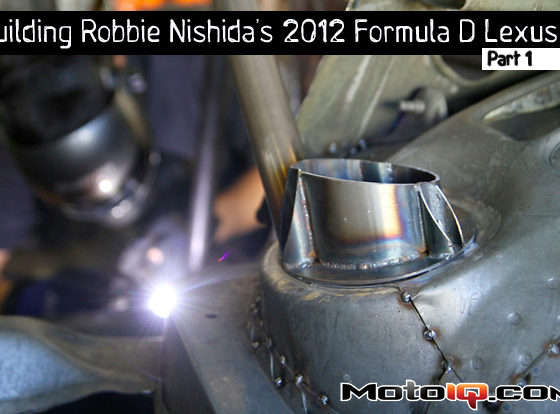,
The biggest driving style change for me in going from a car to a kart is due to the solid rear axle and rear brake used on these karts. I am used to getting on the brakes very hard in a car, but that will cause the rear axle (and therefore tires) to lock up on the kart resulting in an instant spin; I spun twice in the first two laps. Once I recalibrated to the kart brakes, I was fine the rest of the day. However, for that first session, I was screwed as I was hoping to stay with the pack to learn the lines and techniques but now I found myself half a lap back.
After the first session, I got to talking with Craig and a racer named Steve who had extensive karting experience. Karting is similar to riding a motorcycle in the aspect of the driver being able to affect performance by shifting their body weight. Steve suggested I try shifting my body weight to the outside of the kart in a corner to help load up the rear outside tire for traction. Steve also mentioned two other karting tricks I found very interesting. The first is using your body to effectively stiffen up the kart to change its handling characteristics; this is done by using your arms to push against the steering wheel and pressing your body into the seat. I speculate it is basically your body becoming a chassis brace. The other little trick has to do with the centrifugal clutch. The drivers will bounce up and down in the seat to take load off the rear thereby reducing the load on the clutch and helping it spin up faster; you can actually hear the change in engine pitch while looking like a bobble head bouncing up and down in your seat. I tried it a few times and it does seem to help the kart accelerate out of the slower corners.
Craig brought up an interesting point related to going through slower and tighter corners. The rear axle is solid meaning there is no rear differential causing one of the rear tires to get dragged anytime the kart is turning. So when trying to accelerate out of a slower and tight corner, the goal is to try to straighten out the kart as quickly as possible on corner exit so as to not bog down the engine dragging a rear tire around. I suppose this translates well to F1 and any other high power race car as I would guess that they want to get as straight as quickly as possible so they can put the power down.
The last major adaptation I had to make was getting the kart turned. Many of the medium speed corners seemed to require a pitching technique combined with a bit of lift-throttle to get the nose pointed in the correct direction; I imagine this is more similar to drifting or rally driving than typical road racing. Craig and Steve again provided valuable information in regards to this as I was braking too much and bleeding off too much speed. As these karts are relatively low powered, maintaining momentum is everything. Through the first complex of turns after the start-finish line, I had been braking before initiating turn-in. Steve suggested just a quick lift-throttle to transfer weight onto the front tires, a quick turn-in to get the nose pointed in the correct direction and back onto the throttle controlling the drift out of the corner. With that little change in technique, I gained almost a second in the first section alone.
 |
| The apex of this right-hand corner is way back at the row of tires. This was a corner where I was initially braking before turning in. With the change in driving style to a quick-lift and drift, I shaved almost a second from my lap time in just this section. Notice the hand positions of all the drivers in the picture; they are all at a neutral to counter-steering angle. The kart in the background is counter-steering after passing through the apex of the corner. |
Basically, it seemed to me that every medium speed corner was a controlled drift with even the higher speed corners requiring a very fine balance between neutral and oversteer. I imagine this must be due to a lack of a rear differential; with no rear diff, going slow would be the only way to keep the rear from sliding and we certainly don’t want to go slow! Fast hands are required to keep the kart balanced and in the proper trajectory; fast hands are another skill required when driving at the limit to maintain control. Watch the hands of F1 drivers and you can see how quickly they need to make steering corrections. Without fast hands, a little oversteer turns into a lot of oversteer resulting in speed being scrubbed off. This is the last thing you want in a low powered vehicle.
Check out the speed of Mark Webber’s corrections. Keep in mind he’s driving between very hard concrete walls and F1 cars are relatively fragile.
The best thing about karting for a normal guy like me is that it allows me to do some real wheel-to-wheel racing. It’s a great place to practice driving in traffic, reading traffic, defending position and setting up passes. These skills are critical, especially in LeMans and Touring car races where there are often different classes of cars on track. Being able to read and anticipate traffic in order to make the quickest pass possible can be the difference between winning and losing. Race craft is something that you just cannot really learn doing HPDEs.
The last aspect of karting is the physicality. Karting will beat you up and wear you down. Driver fitness is critical to being fast over the course of a race as mental concentration suffers when fatigue sets in. Near the end of our third session of the day, I was definitely getting tired and it negatively impacted my driving. I was missing my apexes by six inches to a foot and killing my lap times. This was critical in a few corners as being just six inches off meant being on a part of the track with substantially less grip. Top level professional drivers are also high level endurance athletes. Many are cyclists and also cross train with running and swimming. Craig may have about two decades on me, but I can tell you he’d finish an Ironman before I even got through any one portion of the three in the race. MotoGP racer Nicky Hayden uses cycling to improve his fitness. The winners of the Nissan GT Academy ran the New York marathon as part of their training. Road racer Katherine Legge does an 18000-calorie-a-week workout program as part of her training regimen which is roughly the equivalent of running ten miles a day. As Tyler McQuarrie posted, he uses his sweet Cervelo bike for training. If you want to stay fast over the course of a race, you better be in shape!
A couple laps from a camera I had mounted on my helmet.
Karting is a great tool for staying sharp in many aspects related to racing. It requires fast hands and control to keep the kart finely balanced on the edge for maximum cornering speed. Racing wheel-to-wheel in traffic is training mentally and allows for practicing race craft. Karting is a decent workout too. If you want to become a well-rounded driver, karting is a great training ground.
 |
||
| A day of karting is always a good day. “Today I didn’t even have to use my A.K.” – Ice Cube |



